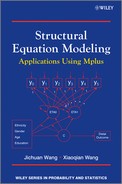Chapter 4
Latent Growth Models for Longitudinal Data Analysis
In this chapter we will expand the application of SEM to longitudinal data analysis where subjects are followed up over time with repeated measures of each variable of interest. The distinctive features of longitudinal data include, but are not limited to: (1) there are different sources of heterogeneity: within-subject or intra-subject variation and between-subject or inter-subject variation; (2) within-subject observations are usually not independent; (3) between-subject variation may not be constant over time; and (4) longitudinal data are often incomplete or unbalanced (i.e., number of repeated measures and time intervals between follow-ups vary by subject). Various new statistical methods have been developed for longitudinal data analysis, among which multilevel models (Mason, Wong, and Entwisle, 1983; Goldstein, 1987, 1995; Bryk and Raudenbush, 1992; Raudenbush and Bryk, 2002), generalized estimating equation (GEE) models (Diggle, Liang, and Zeger, 1998), and latent growth models (LGMs) (McArdle and Anderson, 1990; Meredith and Tisak, 1990; Muthén, 1991; Duncan and Duncan, 1994; Willett and Sayer, 1994; Chou, Bentler, and Pentz, 1998; Duncan, Duncan, and Strycker, 2006) have gained popularity in longitudinal studies. All these approaches make it possible to deal with the special features of the longitudinal data. However, compared with multilevel models and GEE models, LGMs are a more generalized approach that can readily include latent variables in modeling and handles multiple outcome growth processes. In this chapter, we will introduce and demonstrate various LGMs, assuming that individual growth trajectories vary randomly around the overall mean growth trajectory. Growth models taking into consideration heterogeneity in growth trajectories will be discussed in Chapter 6.
